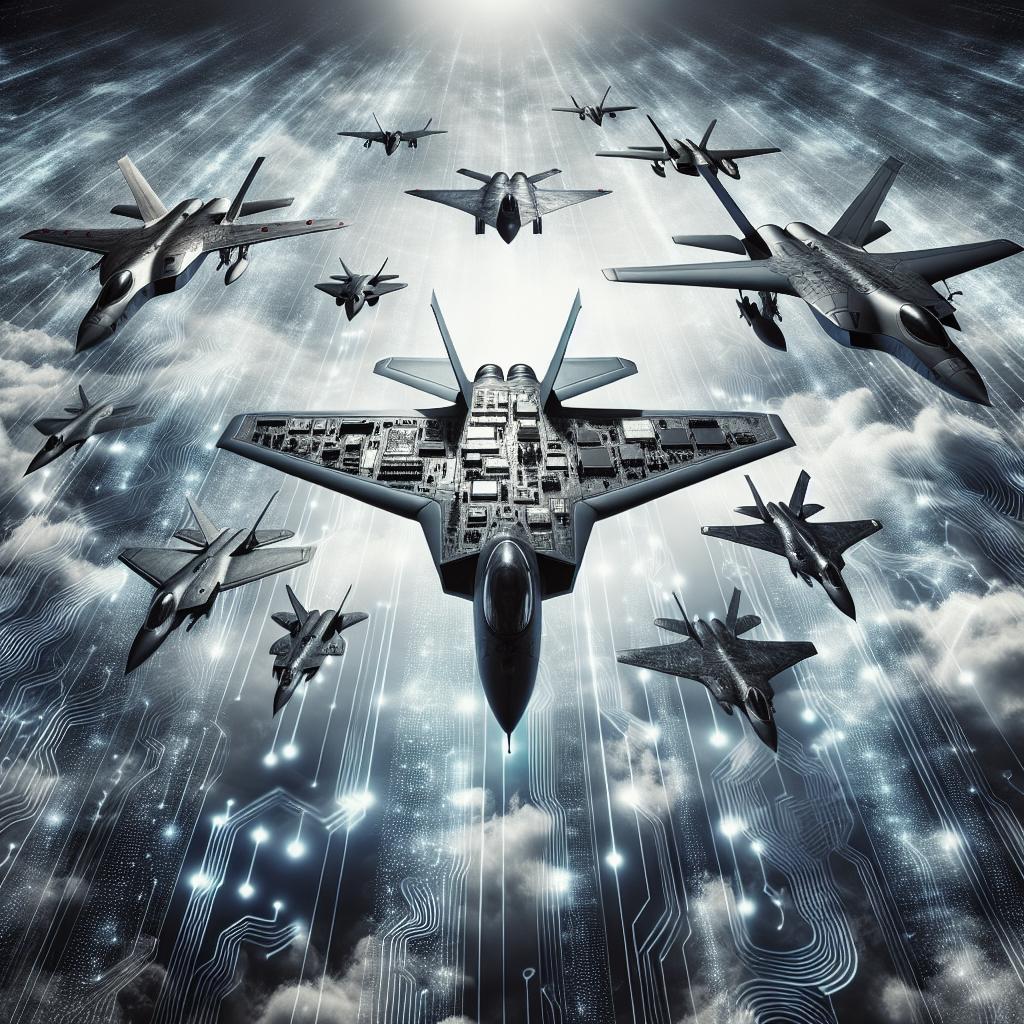 The KC-135 Stratotanker, a stalwart in the U.S. Air Force’s fleet, is a pivotal aircraft designed primarily for mid-air refueling missions, significantly extending the operational range of various aircraft. This blog post delves into the multiple facets of the KC-135, from its sophisticated refueling methods to its modernization programs and performance capabilities. We’ll explore the KC-135’s role in the context of the U.S. military’s broader strategic initiatives, including its capacity to support diverse missions and cargo transport. By the end of this post, you’ll have a well-rounded understanding of the KC-135’s capabilities, operational methods, and the ongoing efforts to keep this essential aircraft at the cutting edge of military aviation. —
From Fighters to Tankers, US Military Flexes Airpower in Middle East as Iran Threatens Israel
The geopolitical landscape in the Middle East has long been a complex and volatile arena. Recently, the U.S. Military has bolstered its presence in the region, deploying a range of aircraft, including fighter jets and refueling tankers like the KC-135 Stratotanker, to solidify its airpower. This move comes amid escalating tensions as Iran poses an increasing threat to Israel and other allied nations in the region. The KC-135 plays a crucial role in this strategic deployment, providing essential mid-air refueling to extend the reach and endurance of U.S. fighter jets and other military aircraft. By enabling longer flight missions without the need to land for fuel, the KC-135 enhances the operational capability of the U.S. forces, allowing for a rapid and sustained military response in times of crisis.
Summary
This comprehensive blog post examines the KC-135 Stratotanker, emphasizing its critical role in the U.S. Air Force’s operations. We cover its refueling methodologies, cargo capabilities, and modernization programs, providing insight into how this aircraft supports various missions. Additionally, we discuss its performance metrics and engine specifications, highlighting the continuous improvements made to ensure its effectiveness.
Trending Now
In military aviation circles, the buzz around the KC-135 often pertains to its ongoing modernization efforts and operational deployments in hotspot regions. Recently, the focus has shifted to its critical role in the Middle East, where its refueling capabilities are proving to be game-changers. As technological advancements drive innovations in aerial refueling, the KC-135 remains a hot topic due to its adaptability and enduring significance.
Recommended White Papers
– “Aerial Refueling Strategies in Modern Warfare” by Jane Doe – “Technological Evolution of the KC-135” by John Smith – “Enhancing Military Aircraft Performance through Mid-Air Refueling” by Dr. Sarah Johnson
Recommended Buyers Guides
– “Choosing the Right Refueling System” – “Modernization Kits for Legacy Aircraft” – “Comparing Military Aviation Fuel Efficiency”
KC-135 Aerial Refueling Method
The KC-135 Stratotanker employs an advanced aerial refueling method known as the flying boom system. This system utilizes a rigid, telescoping tube controlled by a boom operator to transfer fuel from the tanker to the receiving aircraft. The precision and efficiency of the flying boom system have made the KC-135 an invaluable asset in ensuring the sustained air superiority of U.S. forces. In addition to the flying boom, the KC-135 can be equipped with a multipoint refueling system (MPRS) that allows for simultaneous refueling of multiple aircraft using wing-mounted hose and drogue units. This versatility enables the KC-135 to support a wide array of U.S. and allied aircraft, enhancing joint operations and mission flexibility.
Stratotanker Hose and Drogue Air Refueling
A key feature of the KC-135’s refueling capabilities is its ability to utilize the hose and drogue refueling system. This method involves a flexible hose that trails from a pod mounted on the tanker’s wing, ending in a drogue or basket into which the receiving aircraft plugs a probe. This system is particularly useful for refueling helicopters and certain NATO aircraft that are not compatible with the boom system. The hose and drogue system offers a flexible and reliable refueling option, especially in scenarios requiring rapid refueling of multiple aircraft. The versatility of being able to switch between boom and hose and drogue refueling makes the KC-135 a multifaceted tool in various theaters of operation, efficiently sustaining air missions over extended periods.
Cargo
While the KC-135 Stratotanker is primarily designed for aerial refueling, it also boasts significant cargo capabilities. The aircraft can be configured to transport cargo pallets, personnel, and medical evacuation patients, making it a versatile asset beyond its primary refueling mission. With a maximum cargo capacity of approximately 83,000 pounds, the KC-135 can quickly adapt to urgent transport requirements. This dual capability ensures that the KC-135 can serve multiple roles within the U.S. Air Force, from logistical support to humanitarian missions. Whether it’s delivering essential supplies to remote locations or evacuating injured personnel, the cargo capacity of the KC-135 strengthens its operational utility in diverse scenarios.
KC-135 Stratotanker Modernization Program
The continued relevance of the KC-135 in modern military operations is a testament to the U.S. Air Force’s robust modernization programs. These initiatives include upgrading avionics, installing advanced communication systems, and enhancing defensive capabilities. The modernization efforts aim to extend the service life of the Stratotanker while ensuring it meets contemporary operational demands. One notable element of this modernization is the Pacer CRAG (Compass, Radar, and GPS) program, which has significantly improved the navigational accuracy and situational awareness of the KC-135. Additionally, ongoing engine upgrades and structural reinforcements have further increased the reliability and performance of these venerable aircraft, enabling them to serve effectively for decades to come.
Mission Variants
The flexibility of the KC-135 Stratotanker extends to its various mission variants, each tailored to meet specific operational requirements. The KC-135R, for example, is an upgraded model featuring more powerful CFM56 engines and advanced avionics, enhancing fuel efficiency and operational range. Another variant, the RC-135, is designed for reconnaissance missions, equipped with sophisticated sensors and communication equipment. Specialized variants such as the WC-135 are configured for atmospheric sampling, detecting nuclear explosions, and monitoring radiation levels. These mission-specific modifications underscore the adaptability of the KC-135 platform, which continues to play a pivotal role in a wide range of U.S. Air Force missions and strategic initiatives.
Engines
The KC-135 Stratotanker is powered by four turbofan engines, which provide the necessary thrust for its refueling and cargo missions. The most common engines used are the Pratt & Whitney TF33-PW-102s or the CFM International CFM56-2 high-bypass turbofan engines in the upgraded KC-135R models. These engines offer a balance of thrust, fuel efficiency, and reliability, ensuring the Stratotanker can perform its mission with minimal downtime. The transition to CFM56 engines in the KC-135R variant has resulted in notable improvements in fuel efficiency and operational range, as well as reduced maintenance requirements. These engine upgrades are a critical component of the aircraft’s modernization efforts, enhancing the overall performance and longevity of the KC-135 fleet.
Performance
The performance capabilities of the KC-135 Stratotanker are a cornerstone of its operational success. With a maximum takeoff weight of around 322,500 pounds and a maximum fuel capacity exceeding 200,000 pounds, the aircraft can refuel multiple fighter jets or heavy bombers in a single sortie. Its range of approximately 1,500 nautical miles with a full fuel load allows it to support distant and prolonged missions. The KC-135 can cruise at speeds of up to 530 miles per hour and operate at altitudes up to 50,000 feet. These performance metrics ensure the Stratotanker can efficiently execute refueling operations in diverse environments, from high-threat combat zones to remote areas with limited infrastructure. The aircraft’s rugged design and proven reliability further cement its role as an indispensable asset in the U.S. Air Force’s arsenal.
Recommended White Papers
– “Aerial Refueling in the 21st Century: Innovations and Strategies” by Emily Brown – “Maximizing Efficiency and Performance in Military Aviation” by Michael White – “Sustaining Legacy Aircraft through Modernization Programs” by David Turner
Recommended Buyer’s Guides
– “Retrofitting Military Aircraft with Advanced Systems” – “Evaluating Refueling Technologies and Options” – “Comprehensive Guide to Military Aircraft Maintenance” —
| Section | Key Points |
|---|---|
| From Fighters to Tankers, US Military Flexes Airpower in Middle East as Iran Threatens Israel | U.S. military’s strategic deployment, KC-135’s critical role, enhanced operational range |
| Summary | Overview of KC-135’s capabilities, refueling methods, modernization, and performance metrics |
| Trending Now | Focus on modernization programs, operational deployments, and technological advancements |
| KC-135 Aerial Refueling Method | Flying boom system, multipoint refueling system for versatility |
| Stratotanker Hose and Drogue Air Refueling | Flexible hose system, refueling multiple aircraft, versatility in operations |
| Cargo | Maximum capacity of 83,000 pounds, dual role beyond refueling |
| KC-135 Stratotanker Modernization Program | Pacer CRAG program, ongoing engine upgrades, structural reinforcements |
| Mission Variants | KC-135R, RC-135, WC-135, specialized modifications for various missions |
| Engines | Pratt & Whitney TF33-PW-102, CFM56-2, improved fuel efficiency and maintenance |
| Performance | Maximum takeoff weight of 322,500 pounds, refueling capacity, operational range |
| Recommended White Papers | White papers on refueling innovations, aircraft efficiency, and modernization strategies |
| Recommended Buyer’s Guides | Guides on retrofitting aircraft, evaluating refueling technologies, maintenance |


